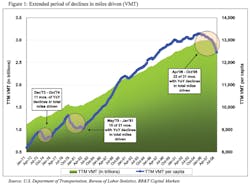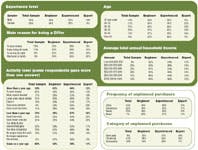Diesel performance is no longer an oxymoron.
More than 50 percent of the vehicles sold in Europe today have diesel engines. Sure, some of them are tiny little cars with tiny little diesel engines designed for the ultimate in fuel economy. But some diesel powerplants are fitted into premium luxury cars from BMW and Mercedes-Benz. These are not tiny, low-powered engines. They are, in fact, performance diesel engines that deliver adequate horsepower and incredible torque without excess noise or smoke. And they provide fuel economy from 30 to 35 percent better than a gasoline engine. Make no mistake; the diesel engine will be the first of the practical alternative fuel engines to make a serious impact in the U.S. The diesels are coming.A BAD REPUTATION
The average American motorist, when it comes to diesel engines, thinks negative. They remember the early VW Rabbit diesel engines and the early GM diesels. Both of these engines were converted to diesel from gasoline and both suffered major problems. The Rabbit diesel used to continue running, even when the motorist turned off the key. Why?
The engine sucked oil from the crankcase and it continued to run (badly). The GM diesels were notorious for head gasket failure and why not? How could a modified gasoline engine cylinder head originally designed to handle static compression ratios of 10.5:1 be expected to handle the ultra-high compression ratios of a compression ignition engine?Motorists also remember the dirty, smelly diesel buses and old Peugeots that were slow and spewed smoke and fumes. It will take some time and education for U.S. motorists to embrace diesel engines once again. The good news is that diesel engines have come a long way from their slow and smoky days. Modern diesel engines with common rail fuel injection, turbocharging, supercharging, or both low-sulfur diesel fuel and particulate emission filters are quiet and almost transparent. Only someone outside a new Mercedes-Benz diesel would suspect the vehicle is fitted with a diesel powerplant.
U.S. motorists have already embraced diesel-powered full-size pickup trucks. The Dodge Ram with its Cummins (not Cummings), the Chevrolet Silverado and GMC Sierra with their Duramax engines, and the Ford F-Series with its Navistar diesel engines are selling and continue to sell well. It won't be too much longer until cars—both economy and premium—with diesel engines join them on America's highways.
With that diesel revolution in mind, SEMA sponsored a Diesel Performance Panel at the recent SEMA Show during Industry Week in Las Vegas. The panel included experts that ranged from a diesel motorsports racing official to FIA land-speed record holder Gale Banks, whose diesel-powered pickup truck towed a trailer to Bonneville, then unhooked it and traveled more than 220 miles per hour. The room was filled to capacity as the speakers brought us up to date on diesel performance.
The first speaker was Ron Knoch from the National Association of Diesel Motorsports (NADM). "This [diesel performance] is one movement that reversed the conventional wisdom," Knoch said. "Unlike most trends, it didn't start on the coasts and move to the Midwest. Instead, diesel performance started in the Midwest and expanded to the coasts. In the Midwest, the most popular diesel performance activity is sled pulls, which are similar to tractor pulls. On the East Coast, the most popular activity is drag racing and on the West Coast, it's both off roading and drag racing." Knoch didn't mention it, but because Gale Banks was sitting on the panel we'll throw in a little bit of land-speed record racing as well.
"Ten percent of the new products shown at SEMA are for diesel trucks," Knoch pointed out. In NADM, the majority of competitors drive Dodge, then GM, and then Ford, in that order. For those consumers who purchase diesel trucks, the order is Ford first, GM second, and Dodge third. The race teams are small but growing and the parking lots are full of diesel trucks. And, believe me, those consumers have a lot of money invested in their trucks; both from the purchase price and from the aftermarket equipment they install. These truck owners have a high discretionary income and a positive business attitude."
A FAMILY SPORT
"As I said, sled pulls are the largest form of diesel power events. There is lots of power and excitement and it's loud." Knoch said. "Diesel drag racing is also strong. There are work trucks running 10-second quarter miles. The teams are now very professional, both in looks and in action.
"I think what the diesel market needs now is WDs. There is a real opportunity for expansion. Currently, there seems to be a two-step distribution, but that can change. The key word is opportunity.
"There still seems to be some confusion with regard to the new-vehicle warranty. We need to talk to the new-vehicle dealers and educate the buyers about the new-vehicle warranty. Seventy percent of truck buyers have rural roots and they will modify their vehicles. Most diesel-powered vehicles, even those with turbochargers, were designed to deliver the best fuel economy possible. But because diesel has a 30 to 35 percent fuel economy advantage over gasoline engines, there is room for performance improvement and the customer is still able to have that fuel economy advantage. For those improvements, we need to continue to work with the EPA," Knoch concluded.
The next speaker was Darryl Klassen from Bully Dog. "Normally aspirated diesels created negative perception of diesel engines as slow, noisy, and smoky," he said.
"At first, propane injection systems helped produce 'clean' horsepower and later, when diesel went electronic, the plug-in module came into its own just as it did with computer-controlled gasoline engines. Designing a diesel module is complex. It must be tough enough to handle vibration, heat, rain, snow, and other conditions.
"We have offered three generations of module conversions and our Triple Dog system is downloadable and can be 'adjusted on the fly.' Consumers can 'try before they buy' and the system can be upgraded over the Internet.
"Why are diesel engines so popular? That 30 to 35 percent increase in fuel economy is one solid reason. Consumers can save money and the country can possibly save 1.4 million barrels of oil per day. In fact, J.D. Power and Associates predicts that 12 to 15 percent of the new-vehicle market by 2015 will have diesel engines," Klassen said.
Next up to the podium was Brian Ross from Big Dog Performance (BD Performance), who put on a 1970's-type European Afro wig and joked about having hair when he started in the industry.
"We started as a fuel-injection company," he explained. "Then we developed a diesel exhaust brake that didn't stick. Now the OEMs are starting to install them, but it's just another example of an engine breakthrough started by the aftermarket.
"We used to lose about 400 RPM with a fluid coupling in an automatic transmission, so we redesigned the transmission. The first step was to simply increase the line pressure to hold the clutches. Now things are much more sophisticated."
Ross went on to explain that modern diesel engines tended to work better with compound twin turbocharger systems. "One to improve the performance at the bottom end and the second turbocharger to improve performance at the top end," he pointed out.
FUTURE STATUS
The next speaker at the podium was Chris Thomson from Airaid, who talked about vehicles we can expect to see in the future. "Diesels make up more than 50 percent of the vehicles in Europe and Europe is ahead of us, so it's coming. Hard-core automotive hobbyists and die hards want and will build diesel-powered off-highway vehicles, so we need to be ready with the products they will need.
"We also need to sell the sizzle," Thomson explained. "And SEMA is important. We need to work with SEMA and with Washington to make certain the products we make can be sold. In my experience, I have found the rule makers in Washington are not unreasonable. We just need to involve them early and work with them," he added.
The final speaker was Gale Banks from Gale Banks Engineering. Dressed in a short-sleeved white dress shirt and tie, Banks began his remarks by holding up his hand and stating in AA style, "My name is Gale Banks and I am a hot rodder. I sold my first high-performance engine in 1958, so I am coming up on 50 years in the high-performance aftermarket.
"Where is diesel going?" he asked. "And how do we make it even bigger? I can remember a time when diesel engines were so underpowered and slow that driving up the Baker grade to Las Vegas for the SEMA Show in 1982, we needed to stop and shave about halfway up the grade." That perception (correct at the time) and the old Chevrolet diesel engines ruined the reputation of diesel engines in the U.S.
"The way we can help further the acceptance of diesel is through racing. The message is that 'Diesel Kicks Gas' and we are getting it out there," Banks said. "Today, there are diesel versions of high-end European cars, such as BMW. That is helping. And we race and we set records. Our BFT (Big Farm Truck, he explained with a wink) set an FIA record of more than 222 miles per hour at the Bonneville Salt Flats.
"Diesels are doing well in road racing, too. Audi has been tearing things up with diesel power. We have a 700-horsepower Cummins diesel engine and we just ran a test where it ran for 800 hours without lifting. That one made me real nervous," he added.
"We just ran a diesel-powered Chevy S10 pro-stock truck at the drags," said Banks. He showed a video of the run and pointed out that the only smoke we saw was coming from the tires, not the engine. The truck ran the quarter-mile in 8.648 seconds at 150.06 miles per hour. "The difference between today and tomorrow is that if you see smoke, it is wasted fuel. You will see no smoke from a modern diesel performance engine.
"There are 10 million diesel gearheads out there; that's more gearheads per capita than for gasoline engines. Diesel performance will be big. Right now I am working on getting the various sanctioning bodies to allow turbo diesel engines to run nitrous oxide. But it's not for more power as it is with gasoline. Nitrous makes a diesel engine safer and cooler. In addition to the NADM, there are other racing sanctioning bodies that allow diesel and they include the National Hot rod Association (NHRA), SCORE for off-road racing, and NASA road racing.
"With racing success and setting records, it proves we (diesel) have the chops and the credibility," Banks said.
SOURCES
Ron Knoch
Darryl Klassen
Brian Ross
Chris Thomson
Gale Banks




